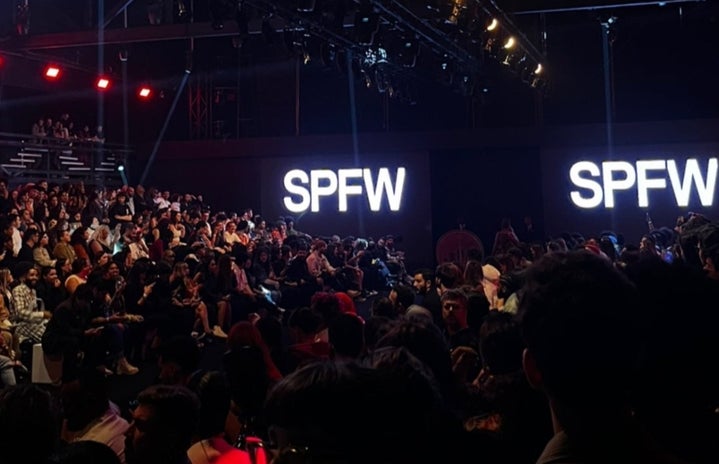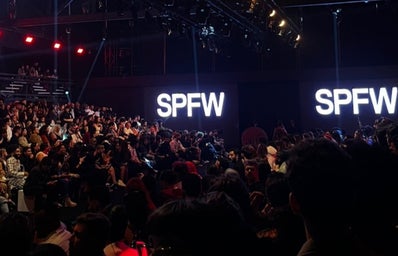I don’t know about you, but I’m currently obsessed with São Paulo Fashion Week. The event is now in its 57th edition and happens between April 9 and 14. Carrying on 29 years of history, find out why SPFW is the biggest fashion event in Brazil!
Where it all started
Initially named Phytoervas Fashion, SPFW was born from a partnership between producer Paulo Borges and businesswoman Cristiana Arcangeli, owner of the brand Phytoervas. The first event took place in 1993 in a warehouse in Vila Olímpia, on the west side of São Paulo, and featured nine shows, including big names in industry such as Alexandre Herchcovitch and Ronaldo Fraga.
At that time in Brazil, much of the clothing production was totally mirrored in Europe, so the purpose was to encourage the construction of national and original designs inspired by Brazilian culture itself.
The end of the Phytoervas Fashion era came in 1996, when Paulo Borges signed a partnership with Shopping Morumbi, creating Morumbi Fashion Week and making it grow even more, thus officially entering the official fashion calendar in Brazil. A favorable factor was also the consolidation of Brazilian models inside and outside the country, such as Gisele Bündchen and Adriana Lima.
It wasn’t until 2001 that the name as we know it became São Paulo Fashion Week.
the person behind the scenes
With so many challenges, the founder and creative director of SPFW, Paulo Borges, never gave up on his idea. He started his career in fashion by helping a friend, a boutique owner, to produce some fashion shows, even though he didn’t have any formal training in the area. But he really took off when he started working for Vogue Brazil journalist Regina Guerreiro, one of the best known and most respected in the Brazilian fashion world.
In the early 90s, Paulo produced fashion shows for the most important brands in the country and in 1993, well, you know what happened! He’s also the founder of Grupo Luminosidade, which produces events and content focused on Fashion.
This inspiring life story you will be able to see first hand in the documentary Paulo Borges – Muito Além da Moda, which will air on Canal E! in 2025, when São Paulo Fashion Week will celebrate 30 years old.
It’s not only in Europe, Brazil has it too
The São Paulo Fashion Show is considered the biggest fashion event in Latin America and ranks fifth in importance worldwide. Honestly, I can’t say I’m surprised, you only have to look at one fashion show to see that SPFW didn’t just come to play, it came to scandalize. It’s an event that values Brazilian culture, where each edition brings technology and innovation, keeping up with changes in fashion.
I wonder if São Paulo Fashion Week or even another fashion event like Tokyo Fashion Week will one day have the same recognition as the European ones.
Being realistic, it’s difficult for this to happen, due to the fact that Europe is the pole of fashion, home to the most famous and traditional brands. And New York Fashion Week, the only non-European, grew out of the unfortunate Second Great War and the famous street style and the advance of the internet in the 2000s.
However, as no one can predict the future and Brazilian culture is gradually being spread around the world, hope cannot be lost.
What to expect
You can’t talk about the past without talking about the future, can you? Here are my predictions for this crucial event:
Fashion is slowly recovering from the pandemic years, so I’m not surprised by the large number of influencers and actors who walk the runways, replacing professional models, since most of them aren’t paid in money but for the visibility that it brings. A negative point for the turnover of this year’s edition was the fact that they stopped selling tickets openly to the public, so only the elite could attend it.
Now the positive thing is that SPFW has been very supportive of sustainability, including brands who value this, such as newcomers Catarina Mina and Reptilia, also valuing themes that refer to this, the theme of N57 is harmony.
Through all its ups and downs, the importance of São Paulo Fashion Week is undeniable: it’s where a brand becomes a designer label and it’s where Brazilian culture also lives on.
——————————————————-
The article above was edited by Larissa Buzon.
Like this type of content? Check out Her Campus Casper Libero for more.


